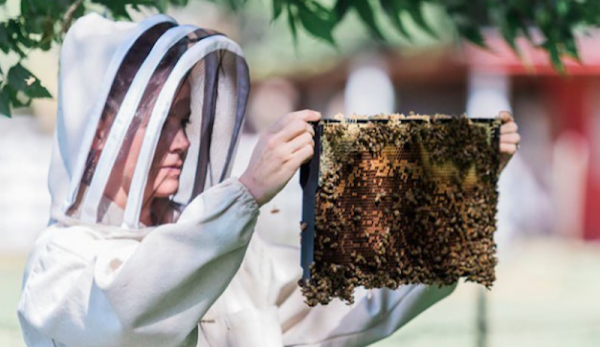
For Lauren Dahl, the journey to homesteading and beekeeping started in college, when she began eating organic food and quickly realized how expensive it could be. “I’d always loved nature and being outside so I started to try and grow my own food,” she recalls. “I failed epically the first couple of years, but I fell in love with it.”
Persisting with the goal of homesteading and growing her own food, Dahl kept steadily increasing the size of her garden. “It’s been a 15-year journey of slowing adding new things to homesteading each year,” says Dahl, who now presides over an organic farm just outside of Austin, Texas, and runs the popular The Living Home Instagram account.
We spoke to Dahl about the benefits of beekeeping and striving to run a zero-waste homestead. We also got into farming as a respite from too much screen time.
Bring on the Bees
Dahl’s adventures in beekeeping began when she was living in the Santa Monica Mountains region of California. “Three ladies went in with me and bought a milk cow. We’d all talked about wanting to get bees, and one day one of the ladies told us she’d ordered us eight bee hives,” she recalls.
Dahl’s initial dalliance with bees didn’t work out. But as soon as she and her husband moved to Texas in December 2019, she added two hives to her land. “I did a lot more reading and research, and I’ve been at that now about a year,” she says.
Read more: Consider these things before getting into beekeeping.
Caring for Bees
View this post on Instagram
When it comes to looking after bee hives, Dahl estimates that “from about March to November, it’s probably an hour every other week” in terms of work load.
“I’ll occasionally walk by them when coming from the barn and have a look. But it’s very low maintenance,” she adds.
Benefits Beyond Honey
View this post on Instagram
Along with producing honey and being “amazing pollinators,” Dahl says one of the biggest joys of keeping bees is the educational element.
“My kids get in the hives with me, and it’s by far the most fascinating part of homesteading,” she explains. “The horses and the milk cow are my favorite, but I could spend hours looking at the bee hives every time I open it up. It’s just amazing.”
Beginning Beekeeping
View this post on Instagram
If you’ve been considering getting into beekeeping, Dahl recommends starting out by checking to see if your local ordinances allow it and then securing two hives.
“That might sound overwhelming. But often if one hive is going downhill you can kinda take resources from the stronger hive,” she explains.
Read more: Do you know how to read a livestock feed bag? This video shows you what to look for.
Striving for Zero Waste
View this post on Instagram
Taking steps to ensure her farm is a toxic-free environment that strives towards zero-waste practices is important for Dahl. As a case in point, she identified the issue of feed coming in bags.
“I found a local feed mill and I bought the big plastic drum barrels and they’ll fill them up for me,” she says. “So I’ve eliminated waste from feed bags.”
Farming to Feel Connected
View this post on Instagram
“To me it’s the connection to nature,” says Dahl when asked what she enjoys and appreciates most about running a homestead and farming.
“So much of our normal life nowadays is computers and screens. I work on the computer in the mornings, then I go outside and do poop work or milk the cow. I feel like it keeps me grounded and connected to real life.”
Follow The Living Home at Instagram.




